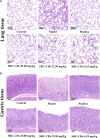Protective effects of Scutellariae Radix Carbonisata-derived carbon dots on blood-heat and hemorrhage rats
- PMID: 37637430
- PMCID: PMC10450154
- DOI: 10.3389/fphar.2023.1118550
Protective effects of Scutellariae Radix Carbonisata-derived carbon dots on blood-heat and hemorrhage rats
Abstract
As the charcoal processing product of Scutellariae Radix (SR), SR Carbonisata (SRC) has been clinically used as a cooling blood and hemostatic agent for thousands of years. However, the underlying active ingredients and mechanism of SRC still remained unspecified. In this study, SRC derived carbon dots (SRC-CDs) were extracted and purified from the aqueous solution of SRC, followed by physicochemical property assessment by series of technologies. The cooling blood and hemostatic effects of SRC-CDs were further evaluated via a blood-heat and hemorrhage (BHH) rat model. Results showed that the diameters of obtained fluorescent SRC-CDs ranged from 5.0 nm to 10.0 nm and possessed functional group-rich surfaces. Additionally, the as-prepared SRC-CDs showed remarkable cooling blood and hemostasis effects in BHH model, mainly manifested by significant improvement of elevated rectal temperature, inflammatory cytokines (TNF-α, IL-6, and IL-1β) levels, as well as protein expressions of myD88 and NF-κB p65, abnormal coagulation parameters (elevated APTT and FIB), hemogram parameters (RBC, HGB, and HCT), and histopathological changes in lung and gastric tissues. This study, for the first time, demonstrated that SRC-CDs were the cooling blood and hemostatic active components of SRC, which could inhibit the release of inflammatory cytokines by regulating myD88/NF-κB signaling pathway, and activating the fibrin system and endogenous coagulation pathway. These results not only provide a new perspective for the study of active ingredients of carbonized herbs represented by SRC, but also lay an experimental foundation for the development of next-generation nanomedicines.
Keywords: Scutellariae Radix Carbonisata-derived carbon dots (SRC-CDs); active ingredients; anti-inflammation; cooling blood and hemostatic effects; hemostasis.
Copyright © 2023 Zhang, Cheng, Luo, Li, Hou, Zhao, Wang, Qu and Kong.
Conflict of interest statement
Author TH was employed by the company Merck & Co., Inc. The remaining authors declare that the research was conducted in the absence of any commercial or financial relationships that could be construed as a potential conflict of interest.
Figures








References
-
- Cao J., Xu X., Jin B., Xiao G. (2012). Functional groups evolvement and charcoal formation during lignin pyrolysis/carbonization. J. Southeast Univ. Sci. Ed. 42, 83–87. 10.3969/j.issn.1001-0505.2012.01.016 - DOI
LinkOut - more resources
Full Text Sources
Research Materials
Miscellaneous

